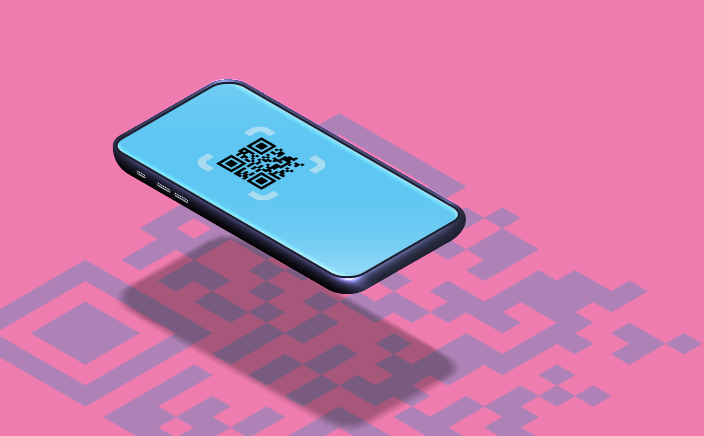
Developed back in 1994, QR Codes (Quick Response Codes) were expected to take off and become a universally-accepted technology that would bridge the physical and the digital divide, connecting offline and online worlds with ease and ushering in a new era of connectivity with benefits for all.
But by 2017, the QR code was on the way out, with a variety of more exciting technologies, including Near Field Communication (NFC) tags and SnapTags, expected to supersede the humble black and white pixelated square. This was especially the case in consumer-oriented brand marketing where QR codes were regularly described in terms such as ‘ugly’, ‘generic’ and ‘boring’ by marketers and consumers alike.
Flash forward just a few years to the global pandemic and QR codes have made a meteoric resurgence seemingly overnight by meeting the touch-averse needs of the social distancing age through its enabling of safer interactions and transactions, especially restaurant check-ins.
While most of us had little experience with QR codes until recently, you’d be hard-pressed to find anyone residing in a metropolitan area who doesn’t have a QR code app on their smartphone. So popular are QR codes at the moment that they’ve become so much more than just a means of sharing contact information and are enhancing customer experiences across a range of applications and platforms, from online networking and capturing sales leads to the replacement of printed materials and even gravestones (though this has been in practice since at least 2012).
What is a QR Code?
Naturally, we now all know what a QR code is, but what are they exactly and how do they work? Essentially, a QR code is a matrix barcode (machine-scannable optical label) comprised of the following seven components:
- Data and error correction keys
- Positioning detection markers
- Alignment markings
- Version information
- Format information
- Timing pattern
- Quiet zone.
These encrypted squares can contain a variety of alphanumeric information, such as website and social media links, concert and event tickets, shopping coupons and other information and details. Unlike barcodes which are typically rectangular and read horizontally, QR codes tend to be square and display the information they contain either horizontally or vertically. This enables the storing of significantly more encrypted data than barcodes, leading to QR codes being used in different ways and for myriad purposes. While barcodes are predominantly used at point of sale to provide pricing and product information, QR codes are used to provide a broad range of intangible information.
A Growing Trend with Extensive Benefits for Business
While it’s taken a global pandemic for QR codes to take off, so integrated have they become into our lives in such a short time that businesses which don’t incorporate them into the delivery or promotion of their products and services could be quickly left behind.
What’s more, as adopting QR code technology is cost-effective and doesn’t require extensive infrastructure, it’s a simple and highly effective way to connect offline and online experiences that any business can leverage to its advantage. While QR codes can be used to connect practically anything physical with anything digital, some of the most common QR code applications for businesses include:
- Directing customers to a web page with detailed information that wouldn’t easily fit on a brochure or physical marketing item
- Providing people with an easy way to register for or obtain event information
- Connecting customers with web pages from physical/printed advertisements
- Sharing digital menus, price lists, tenders and quotations
- Delivering detailed, step-by-step instructional videos
- Delivering Augmented Reality (AR) content
- Directing users to download business apps
- Gathering customer feedback and ratings
- Facilitating registrations and enrolments.
How to Create a QR Barcode
Not sure how QR codes are generated? The process of creating a QR code for your business isn’t only quick and easy, it’s also free — there are seemingly countless free QR code generators, many of which have no scanning limits and enable you to create Quick Response codes that will work forever.
QRCode Monkey, UnitagQR and QR Code Generator are three popular sites to check out if you’re looking to create free QR codes for your business, but there are plenty more that enable you to create high-quality, branded QR codes either for free or as a subscription. There are, however, a few things to consider when searching for a QR code generator, including the following must-have features:
Unlimited Scans: Suffice it to say, if you print hundreds of brochures, invites or billboard posters only to find that after a few scans users are getting redirected to a 404 page, you’ve wasted time, money and effort. If you need to place QR codes on massive print runs regularly, it may be worthwhile opting for a subscription-based QR generator with solid customer support. Be sure to check reviews!
Dynamic QR Codes: As dynamic QR codes can be edited post-printing, they’re ideal for applications that are regularly updated, for example, print and automated marketing, and, orf course, digital marketing, including landing pages and social media promotions. If you don’t want to create a new QR code every time you update your website or social pages, dynamic QR codes are the way to go!
Basic/Advanced Customisations: Basic customisation features like changing the colour or adding a logo are widely available with free QR code generators, but what if you want to add patterns or background images? Advanced customisation features are available with paid QR code generators, including customisable data patterns, background images and colours, colour gradients and CTA frames that can help to increase user engagement and conversion rates.
Robust Analytics: Many free QR Code generators provide basic analytic insights, such as location, time and date, but more advanced (and usually subscription-based) QR code generators also provide Google Analytics integration in addition to more insightful data. This includes an overview of scans by location, the number of scans and unique visitors, top and under-performing QR code campaigns, individual and aggregate scan details, demographic details (age, gender, etc.) and user behaviour.
Advanced QR Code Types: If you need to generate QR codes for different applications, look for a QR code generator that enables you to create a variety of QR code types like vCard, PDF, location, Facebook, event, website and app download QR codes. You should also ensure you can download codes in a range of formats to suit a variety of applications, such as JPEG, PNG and SVG.
User Experience and Safety: One of the most important considerations when using QR codes for business applications is delivering an outstanding user experience and ensuring the safety of your users. QR code generators that enable Single Sign-On (SSO) deliver seamless login experiences and, even more importantly, help to protect users’ information from phishers and hackers. You should also make sure the QR code generator you use is compliant with the latest data privacy laws.
While there are other criteria that you’ll want to consider when looking for the best QR code generator, like competitive pricing and ease-of-use, definitely take the above must-have features into account.
Need help maximising the outcomes of your business promotional materials with QR codes? Get in touch with the team at NOUS at [email protected] or give us a call on (07) 3003 0722.





